Feasibility Study: Iranian Restaurant in London - Startup Analysis
VerifiedAdded on 2022/04/08
|9
|2761
|27
Report
AI Summary
This report presents a feasibility study for an Iranian restaurant startup in London, evaluating its potential for success using the Mullins model. It begins with an introduction discussing the challenges faced by startups and the importance of feasibility studies. The report then analyzes market attractiveness, considering factors like consumer confidence, social trends, and the competitive landscape. It examines market sector benefits, focusing on the target audience of Persian and Asian families. The industry attractiveness is assessed using Porter's Five Forces, and the report highlights the restaurant's sustainable advantages, such as live cooking counters and biodegradable dining ware. The team domain is analyzed, emphasizing the importance of the entrepreneur's and team's motivation. The report concludes that the business has long-term potential with innovation.
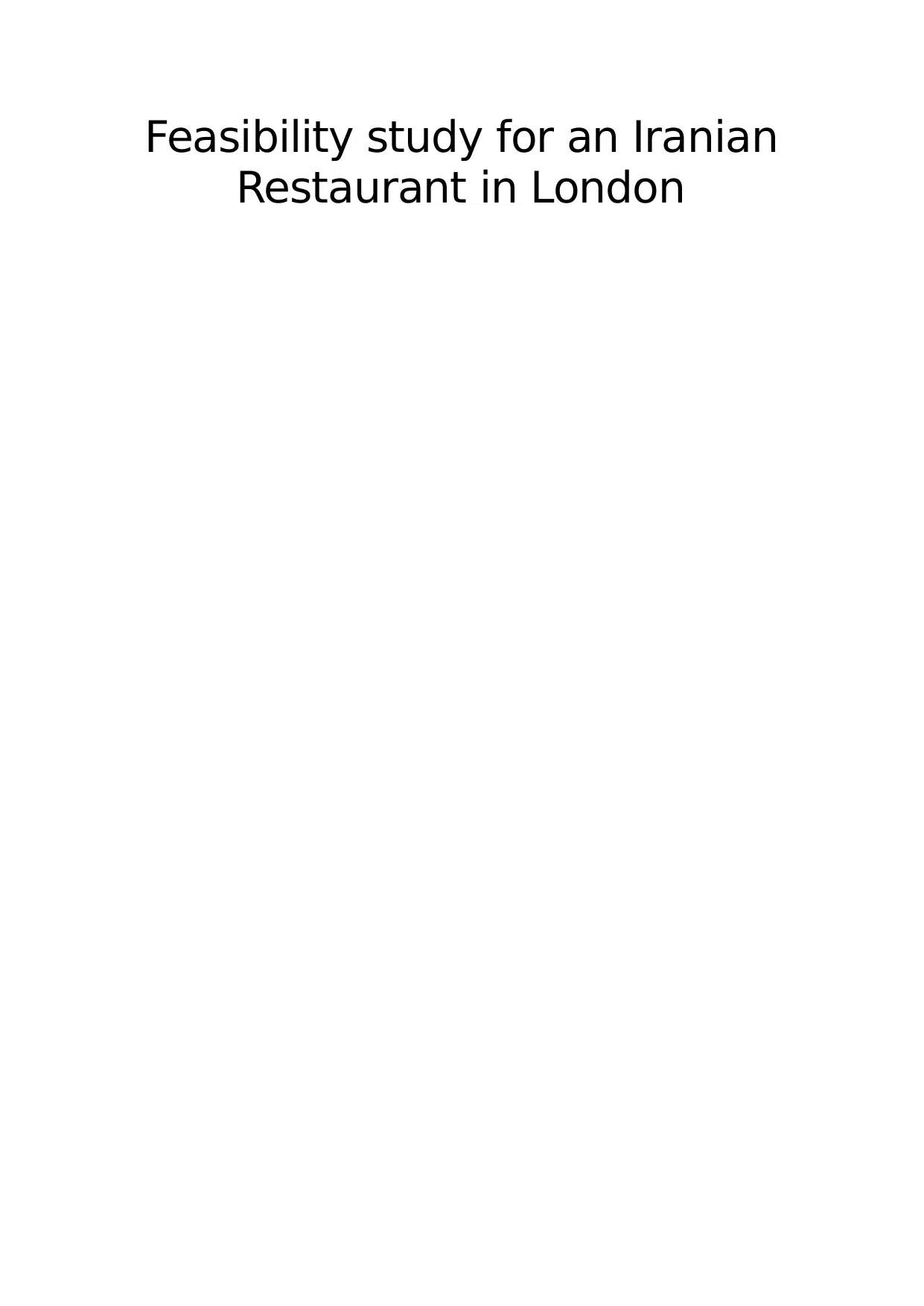
Feasibility study for an Iranian
Restaurant in London
Restaurant in London
Paraphrase This Document
Need a fresh take? Get an instant paraphrase of this document with our AI Paraphraser

Table of Contents
Introduction................................................................................................................................2
Creating opportunities for business through feasibility study....................................................2
Conclusion..................................................................................................................................6
References..................................................................................................................................7
Introduction................................................................................................................................2
Creating opportunities for business through feasibility study....................................................2
Conclusion..................................................................................................................................6
References..................................................................................................................................7
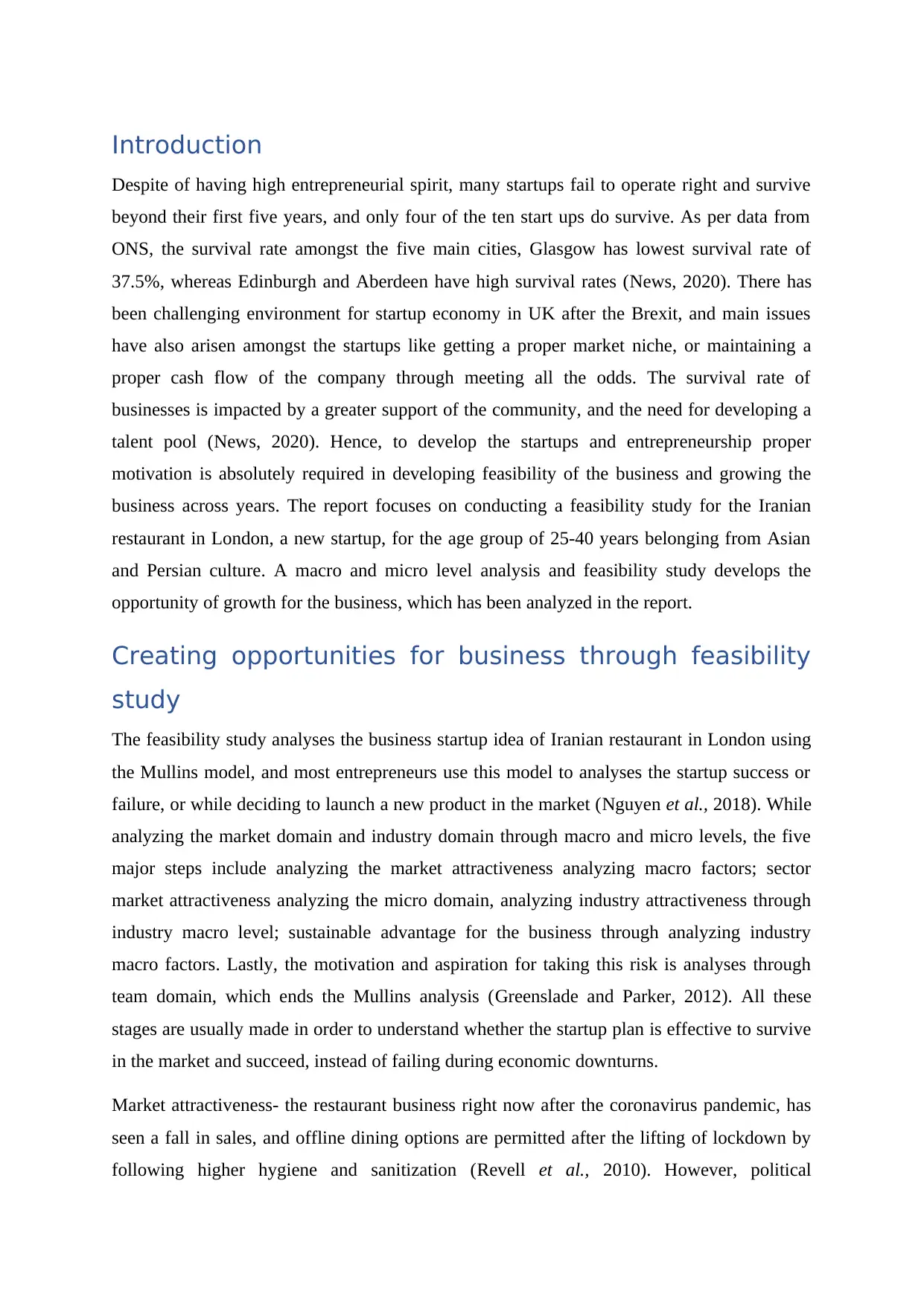
Introduction
Despite of having high entrepreneurial spirit, many startups fail to operate right and survive
beyond their first five years, and only four of the ten start ups do survive. As per data from
ONS, the survival rate amongst the five main cities, Glasgow has lowest survival rate of
37.5%, whereas Edinburgh and Aberdeen have high survival rates (News, 2020). There has
been challenging environment for startup economy in UK after the Brexit, and main issues
have also arisen amongst the startups like getting a proper market niche, or maintaining a
proper cash flow of the company through meeting all the odds. The survival rate of
businesses is impacted by a greater support of the community, and the need for developing a
talent pool (News, 2020). Hence, to develop the startups and entrepreneurship proper
motivation is absolutely required in developing feasibility of the business and growing the
business across years. The report focuses on conducting a feasibility study for the Iranian
restaurant in London, a new startup, for the age group of 25-40 years belonging from Asian
and Persian culture. A macro and micro level analysis and feasibility study develops the
opportunity of growth for the business, which has been analyzed in the report.
Creating opportunities for business through feasibility
study
The feasibility study analyses the business startup idea of Iranian restaurant in London using
the Mullins model, and most entrepreneurs use this model to analyses the startup success or
failure, or while deciding to launch a new product in the market (Nguyen et al., 2018). While
analyzing the market domain and industry domain through macro and micro levels, the five
major steps include analyzing the market attractiveness analyzing macro factors; sector
market attractiveness analyzing the micro domain, analyzing industry attractiveness through
industry macro level; sustainable advantage for the business through analyzing industry
macro factors. Lastly, the motivation and aspiration for taking this risk is analyses through
team domain, which ends the Mullins analysis (Greenslade and Parker, 2012). All these
stages are usually made in order to understand whether the startup plan is effective to survive
in the market and succeed, instead of failing during economic downturns.
Market attractiveness- the restaurant business right now after the coronavirus pandemic, has
seen a fall in sales, and offline dining options are permitted after the lifting of lockdown by
following higher hygiene and sanitization (Revell et al., 2010). However, political
Despite of having high entrepreneurial spirit, many startups fail to operate right and survive
beyond their first five years, and only four of the ten start ups do survive. As per data from
ONS, the survival rate amongst the five main cities, Glasgow has lowest survival rate of
37.5%, whereas Edinburgh and Aberdeen have high survival rates (News, 2020). There has
been challenging environment for startup economy in UK after the Brexit, and main issues
have also arisen amongst the startups like getting a proper market niche, or maintaining a
proper cash flow of the company through meeting all the odds. The survival rate of
businesses is impacted by a greater support of the community, and the need for developing a
talent pool (News, 2020). Hence, to develop the startups and entrepreneurship proper
motivation is absolutely required in developing feasibility of the business and growing the
business across years. The report focuses on conducting a feasibility study for the Iranian
restaurant in London, a new startup, for the age group of 25-40 years belonging from Asian
and Persian culture. A macro and micro level analysis and feasibility study develops the
opportunity of growth for the business, which has been analyzed in the report.
Creating opportunities for business through feasibility
study
The feasibility study analyses the business startup idea of Iranian restaurant in London using
the Mullins model, and most entrepreneurs use this model to analyses the startup success or
failure, or while deciding to launch a new product in the market (Nguyen et al., 2018). While
analyzing the market domain and industry domain through macro and micro levels, the five
major steps include analyzing the market attractiveness analyzing macro factors; sector
market attractiveness analyzing the micro domain, analyzing industry attractiveness through
industry macro level; sustainable advantage for the business through analyzing industry
macro factors. Lastly, the motivation and aspiration for taking this risk is analyses through
team domain, which ends the Mullins analysis (Greenslade and Parker, 2012). All these
stages are usually made in order to understand whether the startup plan is effective to survive
in the market and succeed, instead of failing during economic downturns.
Market attractiveness- the restaurant business right now after the coronavirus pandemic, has
seen a fall in sales, and offline dining options are permitted after the lifting of lockdown by
following higher hygiene and sanitization (Revell et al., 2010). However, political
⊘ This is a preview!⊘
Do you want full access?
Subscribe today to unlock all pages.

Trusted by 1+ million students worldwide

environment also influences the restaurant business, as government regulations in hygiene,
food authority rules, reducing trans-fats, oil, sodium and sugar, along with keeping food
preserved and kitchen tidy. Rights for employees, minimum wage laws are also applicable for
the businesses to run which needs to be acknowledged by all startups. Similarly, after Brexit
the disposable income and purchasing power of people have been reduced (Cho et al., 2020).
Hence opening a startup restaurant with high prices, will not profit. Hence, opening a theme
restaurant with multicuisine and exotic dishes must be value for money, to draw consumer
confidence. The social trends of exotic dishes are always high in London. But after the
pandemic, consumer confidence in eating outside, needs to be developed. Hence, the startup
needs to improve tehri hygiene, sanitization drive to improve their chance to help increase
consumer confidence in their dishes. Using technology is yet another opportunity for the
business to develop their masses, and target audience. Despite these factors, market
attractiveness for the high scale dining in UK is growing saturated (KUMAR, and
GOVINDARAJO, 2017). The market has a large number of players offering choices of food,
and moderate and high price. To scope with these external conditions, the decision makers
should develop tehri exotic themed restaurant to better value-added products maintain proper
hygiene.
Market sector level benefits: the target market are the Persian and Asian families within age
group of 25-40 years, who love to eat own cuisine. The other target group includes curious
customers, who want to try exotic Iranian and Persian food, and eat in London. As the
restaurant is themed, the segment mostly includes the college goers, living in hostels and in
dorms; or those middle aged men working in the UK, and belonging from middle east and
Asian markets (Williams, 2017). The segment of this market is the restaurant themed
segment, and Iranian food is not very much available in comparison to Indian and Chinese
takeout. The middle eastern food as high inclination towards Persian tastes and flavors.
Hence, the whole target audience will be incline within this themed restaurant in London. The
segment of exotic restaurants and diners are increasing at a slow growth curve, but growth
curve nevertheless. The opportunities can be improved further by starting the online sales and
home delivery of Persian and middle eastern food, during the time of pandemic, to improve
sales among online customers as well. The segment of trying new exotic dishes is on the rise
(Shamim, 2019).
Industry attractiveness: the profitability of the industry can be developed through the use of
porter’s 5 forces, in understanding how much the industry has the attraction for investors and
food authority rules, reducing trans-fats, oil, sodium and sugar, along with keeping food
preserved and kitchen tidy. Rights for employees, minimum wage laws are also applicable for
the businesses to run which needs to be acknowledged by all startups. Similarly, after Brexit
the disposable income and purchasing power of people have been reduced (Cho et al., 2020).
Hence opening a startup restaurant with high prices, will not profit. Hence, opening a theme
restaurant with multicuisine and exotic dishes must be value for money, to draw consumer
confidence. The social trends of exotic dishes are always high in London. But after the
pandemic, consumer confidence in eating outside, needs to be developed. Hence, the startup
needs to improve tehri hygiene, sanitization drive to improve their chance to help increase
consumer confidence in their dishes. Using technology is yet another opportunity for the
business to develop their masses, and target audience. Despite these factors, market
attractiveness for the high scale dining in UK is growing saturated (KUMAR, and
GOVINDARAJO, 2017). The market has a large number of players offering choices of food,
and moderate and high price. To scope with these external conditions, the decision makers
should develop tehri exotic themed restaurant to better value-added products maintain proper
hygiene.
Market sector level benefits: the target market are the Persian and Asian families within age
group of 25-40 years, who love to eat own cuisine. The other target group includes curious
customers, who want to try exotic Iranian and Persian food, and eat in London. As the
restaurant is themed, the segment mostly includes the college goers, living in hostels and in
dorms; or those middle aged men working in the UK, and belonging from middle east and
Asian markets (Williams, 2017). The segment of this market is the restaurant themed
segment, and Iranian food is not very much available in comparison to Indian and Chinese
takeout. The middle eastern food as high inclination towards Persian tastes and flavors.
Hence, the whole target audience will be incline within this themed restaurant in London. The
segment of exotic restaurants and diners are increasing at a slow growth curve, but growth
curve nevertheless. The opportunities can be improved further by starting the online sales and
home delivery of Persian and middle eastern food, during the time of pandemic, to improve
sales among online customers as well. The segment of trying new exotic dishes is on the rise
(Shamim, 2019).
Industry attractiveness: the profitability of the industry can be developed through the use of
porter’s 5 forces, in understanding how much the industry has the attraction for investors and
Paraphrase This Document
Need a fresh take? Get an instant paraphrase of this document with our AI Paraphraser
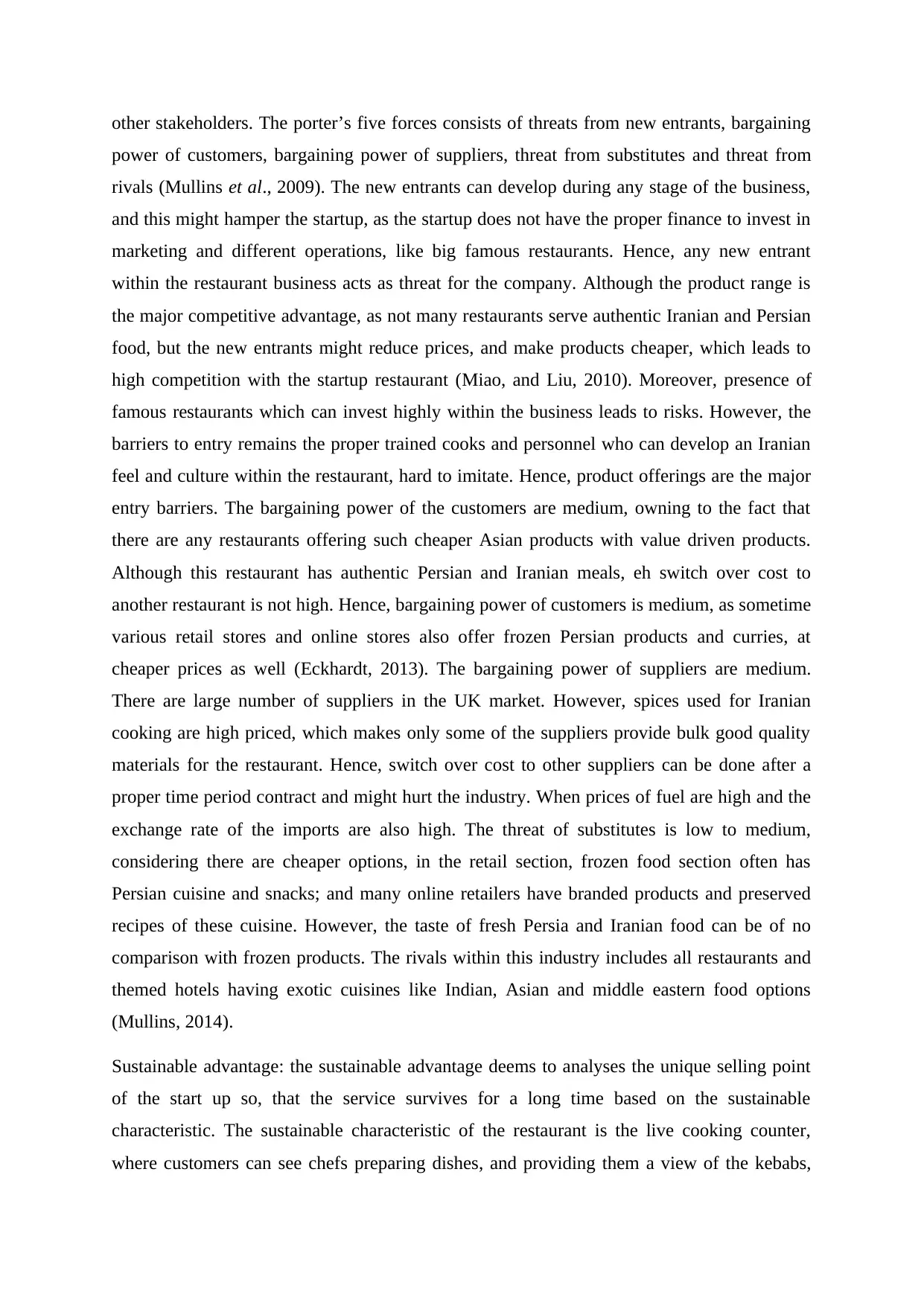
other stakeholders. The porter’s five forces consists of threats from new entrants, bargaining
power of customers, bargaining power of suppliers, threat from substitutes and threat from
rivals (Mullins et al., 2009). The new entrants can develop during any stage of the business,
and this might hamper the startup, as the startup does not have the proper finance to invest in
marketing and different operations, like big famous restaurants. Hence, any new entrant
within the restaurant business acts as threat for the company. Although the product range is
the major competitive advantage, as not many restaurants serve authentic Iranian and Persian
food, but the new entrants might reduce prices, and make products cheaper, which leads to
high competition with the startup restaurant (Miao, and Liu, 2010). Moreover, presence of
famous restaurants which can invest highly within the business leads to risks. However, the
barriers to entry remains the proper trained cooks and personnel who can develop an Iranian
feel and culture within the restaurant, hard to imitate. Hence, product offerings are the major
entry barriers. The bargaining power of the customers are medium, owning to the fact that
there are any restaurants offering such cheaper Asian products with value driven products.
Although this restaurant has authentic Persian and Iranian meals, eh switch over cost to
another restaurant is not high. Hence, bargaining power of customers is medium, as sometime
various retail stores and online stores also offer frozen Persian products and curries, at
cheaper prices as well (Eckhardt, 2013). The bargaining power of suppliers are medium.
There are large number of suppliers in the UK market. However, spices used for Iranian
cooking are high priced, which makes only some of the suppliers provide bulk good quality
materials for the restaurant. Hence, switch over cost to other suppliers can be done after a
proper time period contract and might hurt the industry. When prices of fuel are high and the
exchange rate of the imports are also high. The threat of substitutes is low to medium,
considering there are cheaper options, in the retail section, frozen food section often has
Persian cuisine and snacks; and many online retailers have branded products and preserved
recipes of these cuisine. However, the taste of fresh Persia and Iranian food can be of no
comparison with frozen products. The rivals within this industry includes all restaurants and
themed hotels having exotic cuisines like Indian, Asian and middle eastern food options
(Mullins, 2014).
Sustainable advantage: the sustainable advantage deems to analyses the unique selling point
of the start up so, that the service survives for a long time based on the sustainable
characteristic. The sustainable characteristic of the restaurant is the live cooking counter,
where customers can see chefs preparing dishes, and providing them a view of the kebabs,
power of customers, bargaining power of suppliers, threat from substitutes and threat from
rivals (Mullins et al., 2009). The new entrants can develop during any stage of the business,
and this might hamper the startup, as the startup does not have the proper finance to invest in
marketing and different operations, like big famous restaurants. Hence, any new entrant
within the restaurant business acts as threat for the company. Although the product range is
the major competitive advantage, as not many restaurants serve authentic Iranian and Persian
food, but the new entrants might reduce prices, and make products cheaper, which leads to
high competition with the startup restaurant (Miao, and Liu, 2010). Moreover, presence of
famous restaurants which can invest highly within the business leads to risks. However, the
barriers to entry remains the proper trained cooks and personnel who can develop an Iranian
feel and culture within the restaurant, hard to imitate. Hence, product offerings are the major
entry barriers. The bargaining power of the customers are medium, owning to the fact that
there are any restaurants offering such cheaper Asian products with value driven products.
Although this restaurant has authentic Persian and Iranian meals, eh switch over cost to
another restaurant is not high. Hence, bargaining power of customers is medium, as sometime
various retail stores and online stores also offer frozen Persian products and curries, at
cheaper prices as well (Eckhardt, 2013). The bargaining power of suppliers are medium.
There are large number of suppliers in the UK market. However, spices used for Iranian
cooking are high priced, which makes only some of the suppliers provide bulk good quality
materials for the restaurant. Hence, switch over cost to other suppliers can be done after a
proper time period contract and might hurt the industry. When prices of fuel are high and the
exchange rate of the imports are also high. The threat of substitutes is low to medium,
considering there are cheaper options, in the retail section, frozen food section often has
Persian cuisine and snacks; and many online retailers have branded products and preserved
recipes of these cuisine. However, the taste of fresh Persia and Iranian food can be of no
comparison with frozen products. The rivals within this industry includes all restaurants and
themed hotels having exotic cuisines like Indian, Asian and middle eastern food options
(Mullins, 2014).
Sustainable advantage: the sustainable advantage deems to analyses the unique selling point
of the start up so, that the service survives for a long time based on the sustainable
characteristic. The sustainable characteristic of the restaurant is the live cooking counter,
where customers can see chefs preparing dishes, and providing them a view of the kebabs,
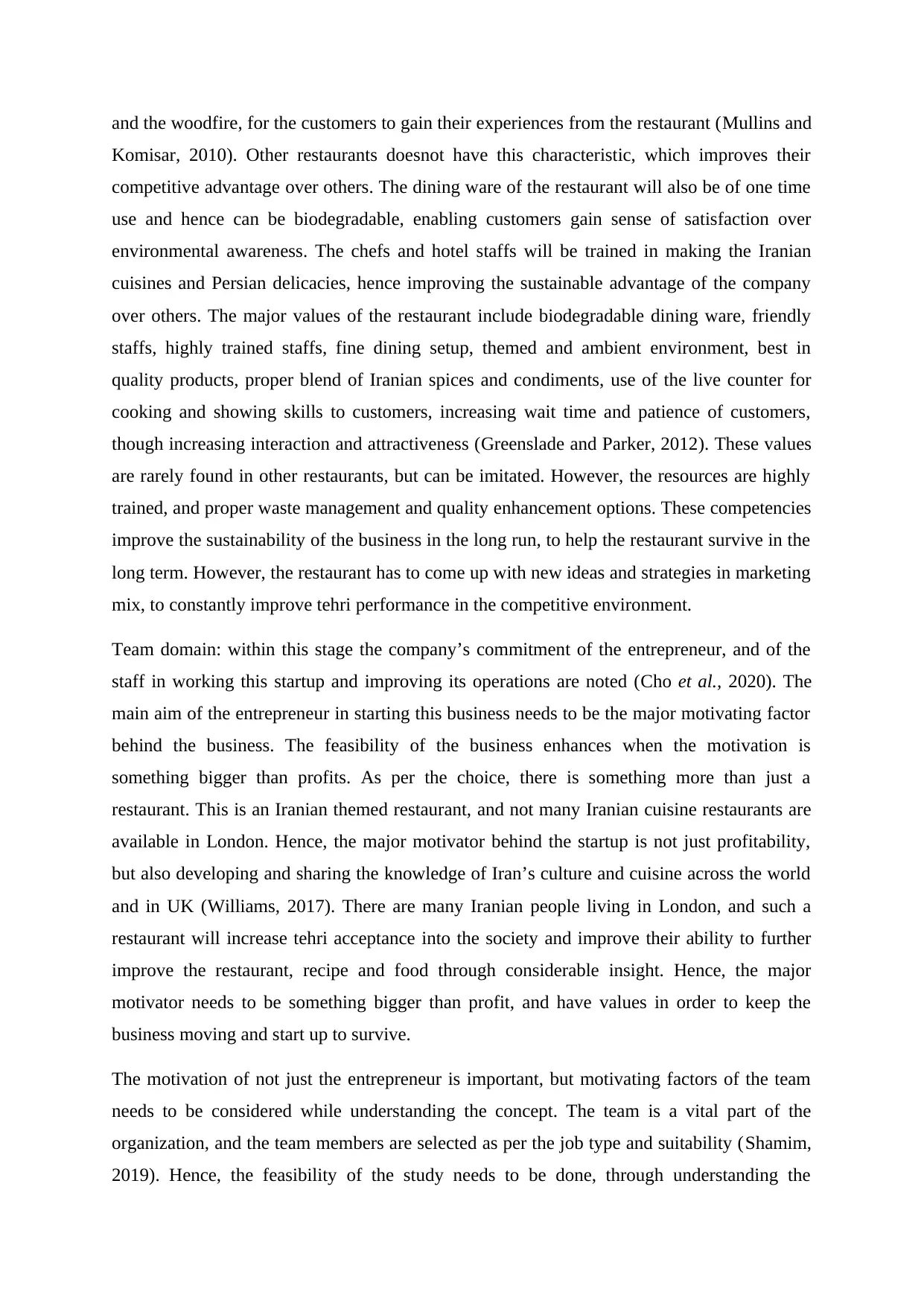
and the woodfire, for the customers to gain their experiences from the restaurant (Mullins and
Komisar, 2010). Other restaurants doesnot have this characteristic, which improves their
competitive advantage over others. The dining ware of the restaurant will also be of one time
use and hence can be biodegradable, enabling customers gain sense of satisfaction over
environmental awareness. The chefs and hotel staffs will be trained in making the Iranian
cuisines and Persian delicacies, hence improving the sustainable advantage of the company
over others. The major values of the restaurant include biodegradable dining ware, friendly
staffs, highly trained staffs, fine dining setup, themed and ambient environment, best in
quality products, proper blend of Iranian spices and condiments, use of the live counter for
cooking and showing skills to customers, increasing wait time and patience of customers,
though increasing interaction and attractiveness (Greenslade and Parker, 2012). These values
are rarely found in other restaurants, but can be imitated. However, the resources are highly
trained, and proper waste management and quality enhancement options. These competencies
improve the sustainability of the business in the long run, to help the restaurant survive in the
long term. However, the restaurant has to come up with new ideas and strategies in marketing
mix, to constantly improve tehri performance in the competitive environment.
Team domain: within this stage the company’s commitment of the entrepreneur, and of the
staff in working this startup and improving its operations are noted (Cho et al., 2020). The
main aim of the entrepreneur in starting this business needs to be the major motivating factor
behind the business. The feasibility of the business enhances when the motivation is
something bigger than profits. As per the choice, there is something more than just a
restaurant. This is an Iranian themed restaurant, and not many Iranian cuisine restaurants are
available in London. Hence, the major motivator behind the startup is not just profitability,
but also developing and sharing the knowledge of Iran’s culture and cuisine across the world
and in UK (Williams, 2017). There are many Iranian people living in London, and such a
restaurant will increase tehri acceptance into the society and improve their ability to further
improve the restaurant, recipe and food through considerable insight. Hence, the major
motivator needs to be something bigger than profit, and have values in order to keep the
business moving and start up to survive.
The motivation of not just the entrepreneur is important, but motivating factors of the team
needs to be considered while understanding the concept. The team is a vital part of the
organization, and the team members are selected as per the job type and suitability (Shamim,
2019). Hence, the feasibility of the study needs to be done, through understanding the
Komisar, 2010). Other restaurants doesnot have this characteristic, which improves their
competitive advantage over others. The dining ware of the restaurant will also be of one time
use and hence can be biodegradable, enabling customers gain sense of satisfaction over
environmental awareness. The chefs and hotel staffs will be trained in making the Iranian
cuisines and Persian delicacies, hence improving the sustainable advantage of the company
over others. The major values of the restaurant include biodegradable dining ware, friendly
staffs, highly trained staffs, fine dining setup, themed and ambient environment, best in
quality products, proper blend of Iranian spices and condiments, use of the live counter for
cooking and showing skills to customers, increasing wait time and patience of customers,
though increasing interaction and attractiveness (Greenslade and Parker, 2012). These values
are rarely found in other restaurants, but can be imitated. However, the resources are highly
trained, and proper waste management and quality enhancement options. These competencies
improve the sustainability of the business in the long run, to help the restaurant survive in the
long term. However, the restaurant has to come up with new ideas and strategies in marketing
mix, to constantly improve tehri performance in the competitive environment.
Team domain: within this stage the company’s commitment of the entrepreneur, and of the
staff in working this startup and improving its operations are noted (Cho et al., 2020). The
main aim of the entrepreneur in starting this business needs to be the major motivating factor
behind the business. The feasibility of the business enhances when the motivation is
something bigger than profits. As per the choice, there is something more than just a
restaurant. This is an Iranian themed restaurant, and not many Iranian cuisine restaurants are
available in London. Hence, the major motivator behind the startup is not just profitability,
but also developing and sharing the knowledge of Iran’s culture and cuisine across the world
and in UK (Williams, 2017). There are many Iranian people living in London, and such a
restaurant will increase tehri acceptance into the society and improve their ability to further
improve the restaurant, recipe and food through considerable insight. Hence, the major
motivator needs to be something bigger than profit, and have values in order to keep the
business moving and start up to survive.
The motivation of not just the entrepreneur is important, but motivating factors of the team
needs to be considered while understanding the concept. The team is a vital part of the
organization, and the team members are selected as per the job type and suitability (Shamim,
2019). Hence, the feasibility of the study needs to be done, through understanding the
⊘ This is a preview!⊘
Do you want full access?
Subscribe today to unlock all pages.

Trusted by 1+ million students worldwide
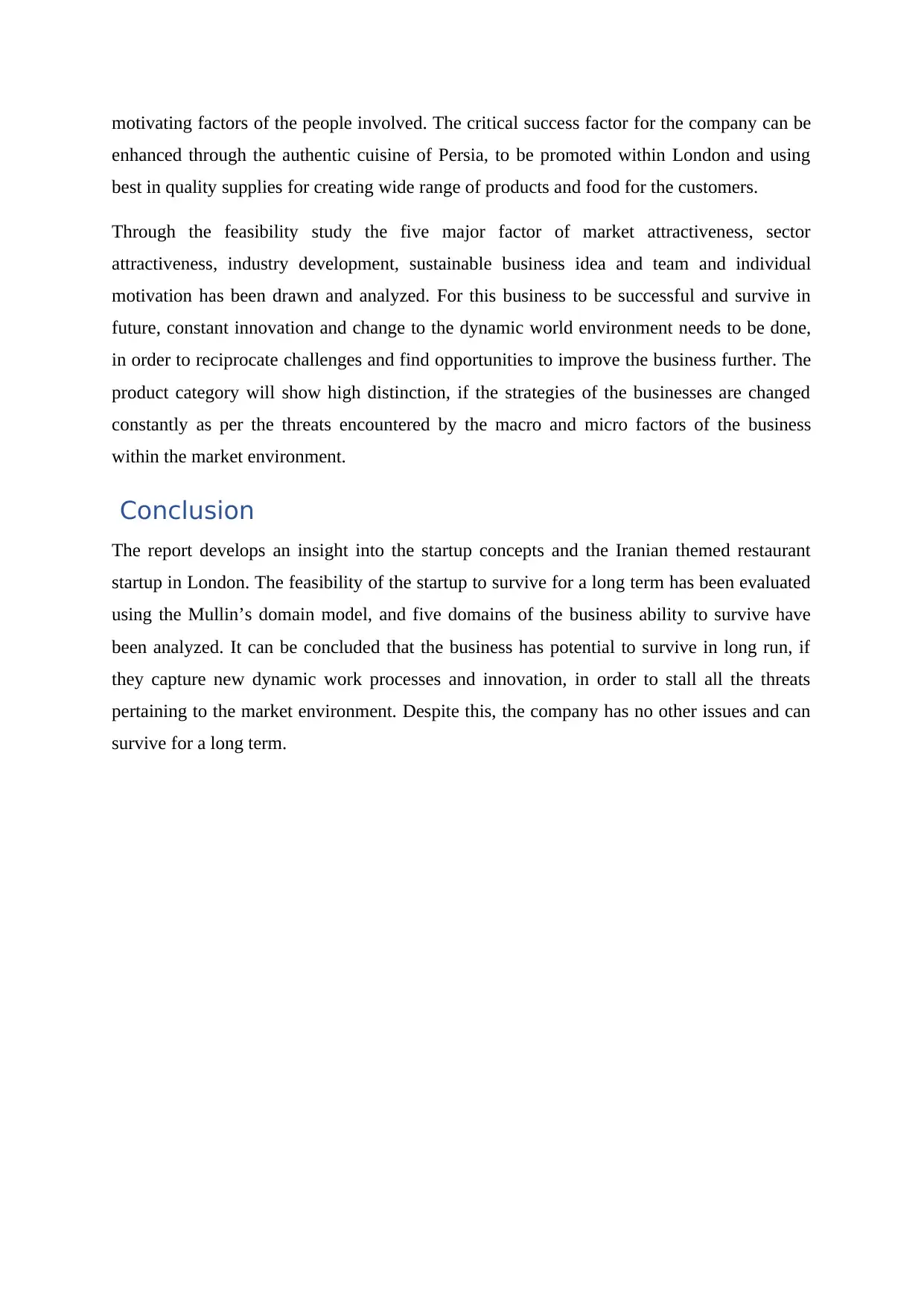
motivating factors of the people involved. The critical success factor for the company can be
enhanced through the authentic cuisine of Persia, to be promoted within London and using
best in quality supplies for creating wide range of products and food for the customers.
Through the feasibility study the five major factor of market attractiveness, sector
attractiveness, industry development, sustainable business idea and team and individual
motivation has been drawn and analyzed. For this business to be successful and survive in
future, constant innovation and change to the dynamic world environment needs to be done,
in order to reciprocate challenges and find opportunities to improve the business further. The
product category will show high distinction, if the strategies of the businesses are changed
constantly as per the threats encountered by the macro and micro factors of the business
within the market environment.
Conclusion
The report develops an insight into the startup concepts and the Iranian themed restaurant
startup in London. The feasibility of the startup to survive for a long term has been evaluated
using the Mullin’s domain model, and five domains of the business ability to survive have
been analyzed. It can be concluded that the business has potential to survive in long run, if
they capture new dynamic work processes and innovation, in order to stall all the threats
pertaining to the market environment. Despite this, the company has no other issues and can
survive for a long term.
enhanced through the authentic cuisine of Persia, to be promoted within London and using
best in quality supplies for creating wide range of products and food for the customers.
Through the feasibility study the five major factor of market attractiveness, sector
attractiveness, industry development, sustainable business idea and team and individual
motivation has been drawn and analyzed. For this business to be successful and survive in
future, constant innovation and change to the dynamic world environment needs to be done,
in order to reciprocate challenges and find opportunities to improve the business further. The
product category will show high distinction, if the strategies of the businesses are changed
constantly as per the threats encountered by the macro and micro factors of the business
within the market environment.
Conclusion
The report develops an insight into the startup concepts and the Iranian themed restaurant
startup in London. The feasibility of the startup to survive for a long term has been evaluated
using the Mullin’s domain model, and five domains of the business ability to survive have
been analyzed. It can be concluded that the business has potential to survive in long run, if
they capture new dynamic work processes and innovation, in order to stall all the threats
pertaining to the market environment. Despite this, the company has no other issues and can
survive for a long term.
Paraphrase This Document
Need a fresh take? Get an instant paraphrase of this document with our AI Paraphraser

References
Cho, M., Bonn, M.A. and Han, S.J., 2020. Innovation ambidexterity: balancing exploitation
and exploration for startup and established restaurants and impacts upon
performance. Industry and Innovation, 27(4), pp.340-362.
Eckhardt, J.T., 2013. Opportunities in business model research. Strategic
Organization, 11(4), pp.412-417.
Greenslade, J.V. and Parker, M., 2012. New insights into price‐setting behaviour in the UK:
Introduction and survey results. The Economic Journal, 122(558), pp.F1-F15.
KUMAR, D. and GOVINDARAJO, N.S., 2017. CASE STUDY:'RECIPE'RESTAURANT
MARKET ANALYSIS AND STRATEGIC SEGMENTATION ISSUES. Qualitative and
Quantitative Research Review, 2(3).
Miao, Q. and Liu, L., 2010. A psychological model of entrepreneurial decision
making. Social Behavior and Personality: an international journal, 38(3), pp.357-363.
Mullins, J., 2014. The customer-funded business: Start, finance, or grow your company with
your customers' cash. John Wiley & Sons.
Mullins, J.W. and Komisar, R., 2010. A business plan? Or a journey to plan B?. MIT Sloan
management review, 51(3), p.1.
Mullins, J.W., Mullins, J.W., Mullins, J. and Komisar, R., 2009. Getting to plan B: Breaking
through to a better business model. Harvard Business Press.
News, S., 2020. Most UK Start-Ups Fail To Survive First Five Years Of Business. [online]
Scottish Financial News. Available at: <https://www.scottishfinancialnews.com/article/most-
uk-start-ups-fail-to-survive-first-five-years-of-business#:~:text=Only%20four%20in%20ten
%20UK,research%20released%20by%20Business%20Comparison.&text=The%20data
%20revealed%20that%20an,in%20business%20five%20years%20later.> [Accessed 8
December 2020].
Nguyen, Q., Nisar, T.M., Knox, D. and Prabhakar, G.P., 2018. Understanding customer
satisfaction in the UK quick service restaurant industry. British Food Journal.
Revell, A., Stokes, D. and Chen, H., 2010. Small businesses and the environment: turning
over a new leaf?. Business strategy and the environment, 19(5), pp.273-288.
Cho, M., Bonn, M.A. and Han, S.J., 2020. Innovation ambidexterity: balancing exploitation
and exploration for startup and established restaurants and impacts upon
performance. Industry and Innovation, 27(4), pp.340-362.
Eckhardt, J.T., 2013. Opportunities in business model research. Strategic
Organization, 11(4), pp.412-417.
Greenslade, J.V. and Parker, M., 2012. New insights into price‐setting behaviour in the UK:
Introduction and survey results. The Economic Journal, 122(558), pp.F1-F15.
KUMAR, D. and GOVINDARAJO, N.S., 2017. CASE STUDY:'RECIPE'RESTAURANT
MARKET ANALYSIS AND STRATEGIC SEGMENTATION ISSUES. Qualitative and
Quantitative Research Review, 2(3).
Miao, Q. and Liu, L., 2010. A psychological model of entrepreneurial decision
making. Social Behavior and Personality: an international journal, 38(3), pp.357-363.
Mullins, J., 2014. The customer-funded business: Start, finance, or grow your company with
your customers' cash. John Wiley & Sons.
Mullins, J.W. and Komisar, R., 2010. A business plan? Or a journey to plan B?. MIT Sloan
management review, 51(3), p.1.
Mullins, J.W., Mullins, J.W., Mullins, J. and Komisar, R., 2009. Getting to plan B: Breaking
through to a better business model. Harvard Business Press.
News, S., 2020. Most UK Start-Ups Fail To Survive First Five Years Of Business. [online]
Scottish Financial News. Available at: <https://www.scottishfinancialnews.com/article/most-
uk-start-ups-fail-to-survive-first-five-years-of-business#:~:text=Only%20four%20in%20ten
%20UK,research%20released%20by%20Business%20Comparison.&text=The%20data
%20revealed%20that%20an,in%20business%20five%20years%20later.> [Accessed 8
December 2020].
Nguyen, Q., Nisar, T.M., Knox, D. and Prabhakar, G.P., 2018. Understanding customer
satisfaction in the UK quick service restaurant industry. British Food Journal.
Revell, A., Stokes, D. and Chen, H., 2010. Small businesses and the environment: turning
over a new leaf?. Business strategy and the environment, 19(5), pp.273-288.
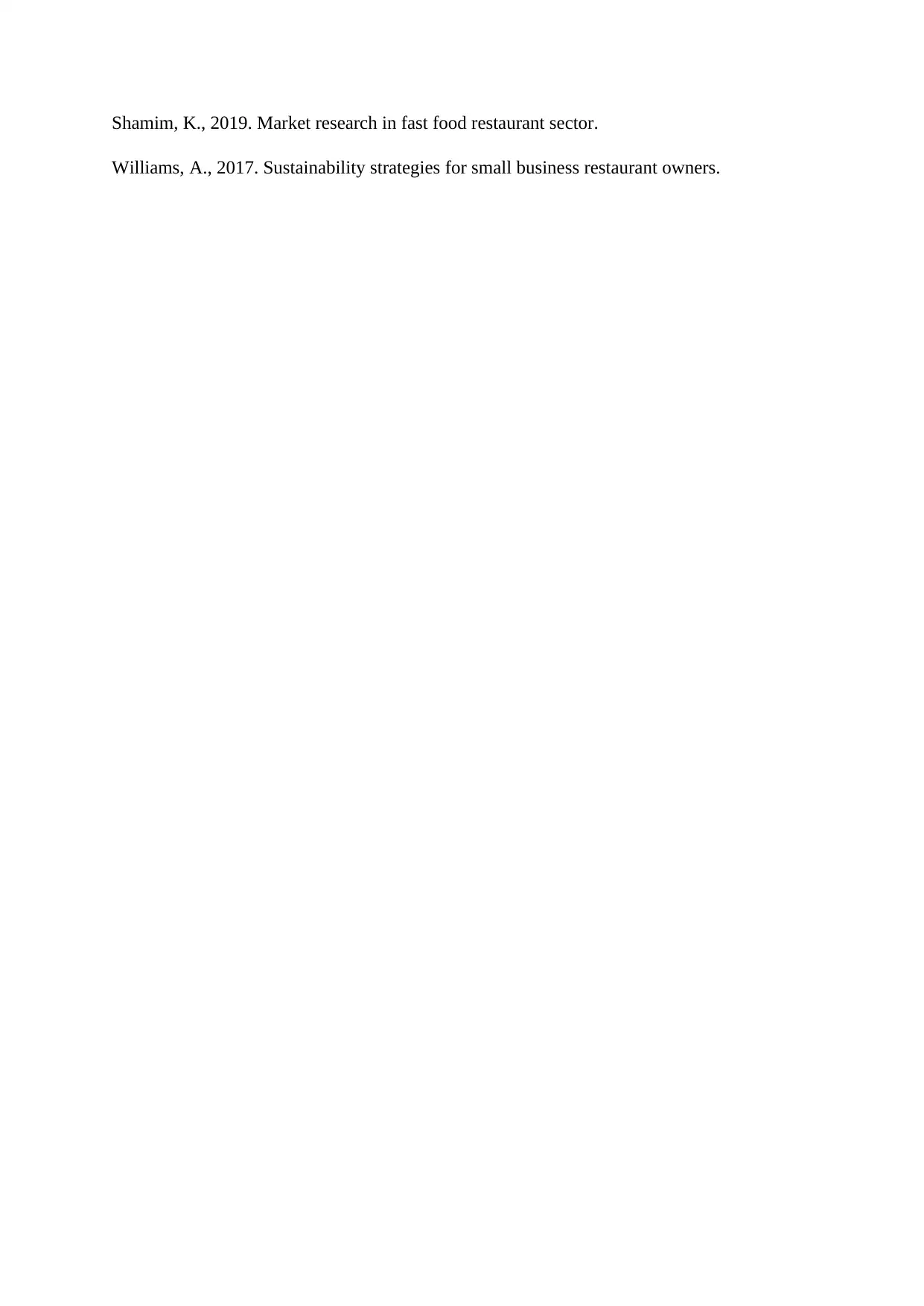
Shamim, K., 2019. Market research in fast food restaurant sector.
Williams, A., 2017. Sustainability strategies for small business restaurant owners.
Williams, A., 2017. Sustainability strategies for small business restaurant owners.
⊘ This is a preview!⊘
Do you want full access?
Subscribe today to unlock all pages.

Trusted by 1+ million students worldwide
1 out of 9
Related Documents
Your All-in-One AI-Powered Toolkit for Academic Success.
+13062052269
info@desklib.com
Available 24*7 on WhatsApp / Email
![[object Object]](/_next/static/media/star-bottom.7253800d.svg)
Unlock your academic potential
Copyright © 2020–2025 A2Z Services. All Rights Reserved. Developed and managed by ZUCOL.





